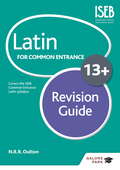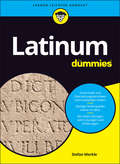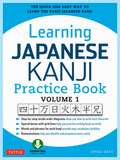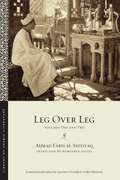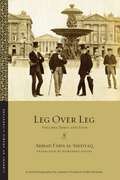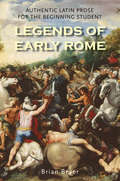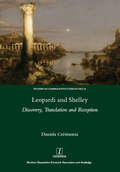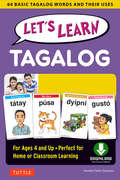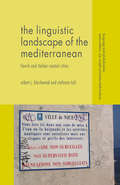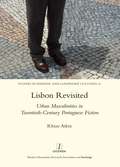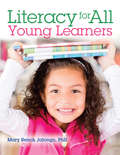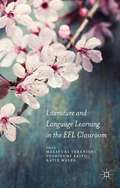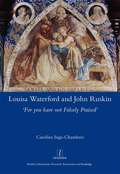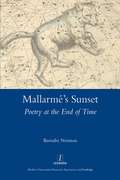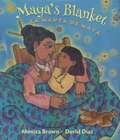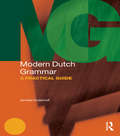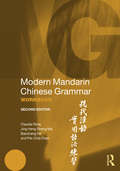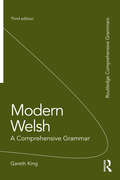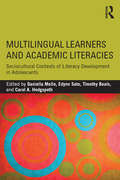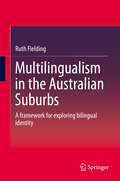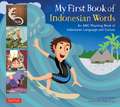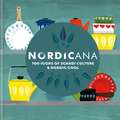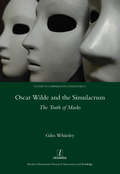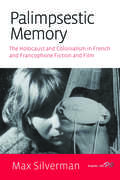- Table View
- List View
Latin for Common Entrance 13+ Revision Guide (for the June 2022 exams)
by N. R. OultonPlease note, this resource is suitable for the exams up to June 2022. New revision resources will be available from Spring 2022 for the exams from November 2022.Exam Board: ISEBLevel: 13+Subject: LatinFirst Teaching: September 2014First Exam: Autumn 2015Updated for the latest ISEB Classics syllabus, this book consolidates all the Latin grammar pupils need to know for the exam into one book, making it an indispensable revision resource for any pupil. It contains clear explanations of all topics, including information on the non-linguistic exam, followed by 'Test Yourself' questions so that pupils can ensure they have understood what they have learnt.- Endorsed by ISEB- Information is presented clearly and methodically to ensure it is accessible for pupils- Includes information on the linguistic and non-linguistic sections so pupils are fully prepared for the Level 1, 2 and 3 ISEB Latin exams- 'Test Yourself' exercises are included so pupils can check their progress- Ideal for using alongside Latin Vocabulary for Key Stage 3 and Common Entrance
Latinum für Dummies (Für Dummies)
by Stefan MerkleGehören auch Sie zu den Studierenden, die an der Uni das Latinum nachholen müssen, weil es eine Voraussetzung für Ihren Abschluss ist, Sie aber in der Schule Latein nicht belegt hatten? Da gibt es sicher Angenehmeres. Aber wenn Sie schon im Lateinkurs sitzen, sollte das Lernen zumindest Spaß machen. Dieses Buch bereitet Sie auf die Klausur vor und hilft Ihnen, sie zu bestehen, auch wenn Sie zuvor keine Lateinkenntnisse hatten. Schritt für Schritt führt Stefan Merkle Sie in die lateinische Grammatik ein. Der Autor weiß, wo es hakt und welche grammatischen Formen besonders knifflig sind. Er vermittelt Übersetzungstechniken und weist Sie auf die häufigsten Fehlerquellen hin. Und nach den nachvollziehbaren Erklärungen heißt es dann üben, üben, üben - getreu dem Motto von null bis Caesar!
Learning Japanese Kanji Practice Book Volume 1: The Quick and Easy Way to Learn the Basic Japanese Kanji
by Eriko SatoThis is an invaluable study guide and practice book for learning basic Japanese kanji.Learning Japanese Kanji Practice Book is intended for beginning students, or experienced speakers who need to practice their written Japanese.<P><P> Kanji are an essential part of the Japanese language and together with kana (hiragana and katakana) comprise written Japanese.This book presents the kanji characters that are most commonly used. All the kanji and related vocabulary words in this book are those that students are expected to know for Level 5 of the Japanese Language Proficiency Test. (JLPT). Characters that appear in the AP Japanese Language and Culture Exam are flagged. Readings, meanings, and common compounds are presented. The correct method of writing each character is clearly indicated and practice boxes with strokes that can be traced are provided, along with empty boxes for freehand writing practice.Lots of exercises are included to give students the opportunity to practice writing sentences containing the Kanji. Indexes at the back allow you to look up the characters by their readings and English meanings.This book includes: Step-by-step stroke order diagrams for each character. Special boxes with grid lines to practice writing characters. Words and phrases using each kanji. Romanizations (romanji) to help identify and pronounce every word.
Learning Latin and Greek from Antiquity to the Present
by Elizabeth P. Archibald William Brockliss Jonathan Gnoza Elizabeth P. Archibald William BrocklissThis volume provides a unique overview of the broad historical, geographical and social range of Latin and Greek as second languages. It elucidates the techniques of Latin and Greek instruction across time and place, and the contrasting socio-political circumstances that contributed to and resulted from this remarkably enduring field of study. Providing a counterweight to previous studies that have focused only on the experience of elite learners, the chapters explore dialogues between center and periphery, between pedagogical conservatism and societal change, between government and the governed. In addition, a number of chapters address the experience of female learners, who have often been excluded from or marginalized by earlier scholarship.
Leg over Leg: Volumes One and Two (Library of Arabic Literature #1)
by Humphrey Davies Ahmad Faris al-ShidyaqLeg over Leg recounts the life, from birth to middle age, of "the Fariyaq," alter ego of Ahmad Faris al-Shidyaq, a pivotal figure in the intellectual and literary history of the modern Arab world. The always edifying and often hilarious adventures of the Fariyaq, as he moves from his native Lebanon to Egypt, Malta, Tunis, England, and France, provide the author with grist for wide-ranging discussions of the intellectual and social issues of his time, including the ignorance and corruption of the Lebanese religious and secular establishments, freedom of conscience, women's rights, sexual relationships between men and women, the manners and customs of Europeans and Middle Easterners, and the differences between contemporary European and Arabic literatures, all the while celebrating the genius and beauty of the classical Arabic language. Volumes One and Two follow the hapless Fariyaq through his youth and early education, his misadventures among the monks of Mount Lebanon, his flight to the Egypt of Muhammad 'Ali, and his subsequent employment with the first Arabic daily newspaper--during which time he suffers a number of diseases that parallel his progress in the sciences of Arabic grammar, and engages in amusing digressions on the table manners of the Druze, young love, snow, and the scandals of the early papacy. This first book also sees the list--of locations in Hell, types of medieval glue, instruments of torture, stars and pre-Islamic idols--come into its own as a signature device of the work. Akin to Sterne and Rabelais in his satirical outlook and technical inventiveness, al-Shidyaq produced in Leg Over Leg a work that is unique and unclassifiable. It was initially widely condemned for its attacks on authority, its religious skepticism, and its "obscenity," and later editions were often abridged. This is the first complete English translation of this groundbreaking work.
Leg over Leg: Volumes Three and Four (Library of Arabic Literature #9)
by Humphrey Davies Ahmad Faris al-Shidyaq<P> Leg over Leg recounts the life, from birth to middle age, of “the Fariyaq,” alter ego of Ahmad Faris al-Shidyaq, a pivotal figure in the intellectual and literary history of the modern Arab world. The always edifying and often hilarious adventures of the Fariyaq, as he moves from his native Lebanon to Egypt, Malta, Tunis, England, and France, provide the author with grist for wide-ranging discussions of the intellectual and social issues of his time, including the ignorance and corruption of the Lebanese religious and secular establishments, freedom of conscience, women’s rights, sexual relationships between men and women, the manners and customs of Europeans and Middle Easterners, and the differences between contemporary European and Arabic literatures, all the while celebrating the genius and beauty of the classical Arabic language. <P> Volumes Three and Four see the peripatetic Fariyaq fall in love and convert to Catholicism for twenty-four hours in order to marry. Although the narrative revolves around a series of debates over the nature of male-female relationships, opportunities also arise for disquisitions on the physical and moral significance of such diverse topics as the buttocks, the unreliability of virginity tests, and the human capacity for self-delusion. Lengthy stays in England and France allow for animadversions on the table manners and sexual aberrations of their citizens, but the discussion, whether it involve dance-halls, pleasure gardens, or poetry, almost always ends up returning to gender relations. <P> Akin to Sterne and Rabelais in his satirical outlook and technical inventiveness, al-Shidyaq produced in Leg Over Leg a work that is unique and unclassifiable. It was initially widely condemned for its attacks on authority, its religious skepticism, and its “obscenity,” and later editions were often abridged. This is the first complete English translation of this groundbreaking work.
Legends of Early Rome
by Brian BeyerIn this text for upper-beginner and intermediate students, Brian Beyer collects authentic Latin prose from Book I of Eutropius's Breviarium ab urbe condita, which covers Roman history from Rome's foundation to the sack of Rome by the Gauls. Eutropius's easy style and accessible vocabulary make his Breviarium ideal for students transitioning from the simplified Latin of a first-year textbook. Bottom-of-the-page glosses, passages in English from the Roman historian Livy, a running commentary on grammar and syntax, historical notes, and compiled vocabulary allow students insight into the foundational myths of ancient Rome and the historical context of Eutropius's narrative.
Leopardi and Shelley: Discovery, Translation and Reception
by Cerimonia DanielaGiacomo Leopardi (1798-1837) and Percy Bysshe Shelley (1792-1822) crossed paths during their lifetimes, and though they never met, the legacy of their work betrays a shared destiny. As prominent figures who challenged and contributed to the Romantic debate, Leopardi and Shelley hold important roles in the history of their respective national literatures, but paradoxically experienced a controversial and delayed reception outside their native lands. Cerimonia�s wide-ranging study brings together these two poets for the first time for an exploration of their afterlives, through a close reading of hitherto unstudied translations. This intriguing journey tells the story, from its origins, of the two poets� critical fortune, and examines their position in the cultural debates of the nineteenth century; in disputes regarding translation theories and practices; and shows the configuration of their identities as we understand their legacy today.
Let's Learn Tagalog: 64 Basic Tagalog Words and Their Uses-For Children Ages 4 and Up
by Imelda Fines GasmenLet's Learn Tagalog Kit is a complete language learning tool specially designed to introduce young children to the basic Tagalog sounds, words, and phrases in a fun and interactive way. <P><P> This kit is perfect for use in a classroom setting, for home schooling, on vacation, or anywhere else that learning takes place. It is intended for learners who have little or no background in the Tagalog language. It contains: 64 flash cards An audio CD with recordings of words, sentences and songs A wall chart showing the main words and phrases at a glance A 32-page Learning Guide for parents and teachers The 64 words are organized into thematic categories, including: My Family Colors Numbers Animals Food My Body Clothes My Day Each word is illustrated with a picture that serves as an effective visual aid to learning and remembering the word. The words often reflect cultural objects and can be studied in any order. Tagalog language learners may focus on one theme at a time or mix them up for greater variety. Simple example sentences are given for each word to show how they are used. The audio CD gives native-speaker pronunciations for all the words and sentences and also contains songs which promote interactive language learning. Finally, the kit includes a wall chart featuring all the pictures and words, and some bonus words; a booklet explaining how to use the flash cards, and additional activities; an audio CD and a wall chart.
The Linguistic Landscape of the Mediterranean: French and Italian Coastal Cities (Language and Globalization)
by Stefania Tufi Robert J. BlackwoodThis book explores the Linguistic Landscapes of ten French and Italian Mediterranean coastal cities. The authors address the national languages, the regional languages and dialects, migrant languages, and the English language, as they collectively mark the public space.
Lisbon Revisited: Urban Masculinities in Twentieth-Century Portuguese Fiction
by Rhian AtkinTwentieth-century Portugal saw dramatic political and social change. The monarchy was abolished, and a republic installed (1910), soon giving way to a long-lasting dictatorship (1926); a transition to democracy (1974) led to membership of the European Union (1986). But what do we know of how people lived during these periods? And how did men, in particular, respond to the changes taking place in society? In this illuminating and broad-ranging study, Rhian Atkin uses as case studies the work of Fernando Pessoa (1888-1935), Luis de Sttau Monteiro (1926-93) and Jose Saramago (1922-2010) in order to examine the relationship between socio-political change and the construction and performance of masculinities in the urban environment of Lisbon over the course of the last century.
Literacy for All Young Learners
by Mary JalongoEarly childhood classrooms are becoming more and more diverse. Dual languages and a wide range of reading abilities require that teachers have the resources to reach all learners in their classrooms. In Literacy for All Young Learners, Mary Jalongo, PhD, offers 65 strategies to support literacy learning with children from preschool through the third grade. With specific suggestions for ELL students, Jalongo includes recommendations for hundreds of great children's books, websites, and apps to make teaching easier. Each strategy is designed to be simple to use with all of the children in your classroom--from the not-yet-readers to the fluent readers--and each strategy is tied to the Common Core State Standards for kindergarten through third grade. Downloadable digital content includes sample parent letters in English and Spanish, extra book-based activities, and technology supports.
Literature and Language Learning in the EFL Classroom
by Masayuki Teranishi Yoshifumi Saito Katie WalesThis book examines how literary texts can be incorporated into teaching practices in an EFL classroom. It takes a multi-faceted approach to how English language teaching and learning can best be developed through presentation and exploration of literary texts.
Louisa Waterford and John Ruskin: 'For You Have Not Falsely Praised'
by Caroline Ings-ChambersLouisa Waterford (1818-91), modest, retiring, of good family, renowned for her beauty, and with extraordinary grace, was the embodiment of a Victorian ideal of womanhood. But like the age itself, her life was filled with contrasts and paradoxes. She had been born with artistic gifts, and became a satellite of the Pre-Raphaelite Brotherhood, though she had no formal training. Then, at the height of John Ruskin's intellectual power and success as a critic, she asked him to accept her as an art student, and he accepted. Their correspondence- often harshly critical, never, as Waterford put it, falsely praising - lies at the heart of this book. These are letters which open a spectrum of discussion on the cultural, gender and social issues of the period. Both Waterford and Ruskin engaged in tireless philanthropic work for diverse causes, crossing social boundaries with subtle determination, and both responded to a sense of duty as well as an artistic vocation. But, as Ings-Chambers shows, their correspondence was more than a dialogue about society: it helped to make Waterford the artist she became.
Mallarme's Sunset: Poetry at the End of Time
by Barnaby NormanThe writings of the great Symbolist poet Stephane Mallarme (1842-1898) were to become uniquely influential in twentieth century literary criticism. For critics and philosophers such as Maurice Blanchot and Jacques Derrida, Mallarme's name came to represent a rupture in literary history, and an opening of literature onto a radically new kind of writing. Through close readings of key works, Norman retraces Mallarme's trajectory as a poet, showing in particular how he positioned his work in relation to Hegel's Aesthetics. Analysing the motif of the sunset Norman argues that Mallarme situated his work at the conclusion of the history of art, in Hegelian terms, and it is this that made him so interesting for Blanchot and Derrida. Their readings, born of their wish to subvert Hegel's totalizing impulse, give rise to an entirely new view of works now almost universally seen as masterpieces.
Modern Dutch Grammar: A Practical Guide (Modern Grammars)
by Jenneke OosterhoffModern Dutch Grammar: A Practical Guide is an innovative reference guide to Dutch, combining traditional and function-based grammar in a single volume. With a strong emphasis on contemporary usage, all grammar points and functions are richly illustrated with examples. The Grammar is divided into two parts. Part I covers traditional grammatical categories such as nouns and verbs. Part II is carefully organized around language functions and contexts such as: Giving and seeking information Describing processes and results Expressing attitudes, mental states and emotions Registers and style Formal and informal communication, e.g. youth talk Main features of the Grammar include: Clear, succinct and jargon-free explanations Extensive cross-referencing between the different sections Emphasis on areas of particular difficulty for learners of Dutch This is the ideal reference grammar for learners of Dutch at all levels, from elementary to advanced; no prior knowledge of grammatical terminology is assumed and it provides indices of grammatical terms and functions. This Grammar is complemented by a companion website featuring related exercises and activities to reinforce learning.
Modern Mandarin Chinese Grammar Workbook (Modern Grammar Workbooks)
by Claudia Ross Baozhang He Pei-Chia Chen Jing-Heng Sheng MaModern Mandarin Chinese Grammar Workbook is a book of exercises and language tasks for all learners of Mandarin Chinese. Divided into two sections, the Workbook initially provides exercises based on essential grammatical structures, and moves on to practice everyday functions such as making introductions, apologizing and expressing needs. With an extensive answer key at the back to enable students to check on their progress, main features include: exercises at various levels of challenge for a broad range of learners cross-referencing to the related Modern Mandarin Chinese Grammar a comprehensive index to exercises alphabetically arranged in terms of structures, functions, and key Chinese structure vocabulary. This second edition also offers a revised and expanded selection of exercises including new task-based exercises. Modern Mandarin Chinese Grammar Workbook is ideal for all learners of Mandarin Chinese, from beginner to intermediate and advanced students. It can be used both independently and alongside the Modern Mandarin Chinese Grammar (978-0-415-82714-0), which is also published by Routledge.
Modern Welsh: A Comprehensive Grammar (Routledge Comprehensive Grammars)
by Gareth KingModern Welsh: A Comprehensive Grammar is the ideal reference source for all speakers and learners of Welsh. Focusing on contemporary spoken Welsh, it presents the complexities of the language in a concise and readable form. Common grammatical patterns and parts of speech are discussed in detail and without jargon and extensive cross references make the book comprehensive and easy to use. Now in its third edition, the Grammar has been thoroughly revised and updated throughout. Changes include an increased number of illustrative examples, additional appendices for easy reference, inclusion of IPA phonetic symbols, and expanded sections on further reading. Features include: Full use of authentic examples Particular attention to areas of confusion and difficulty Extensive index and cross referencing Initial consonant mutations marked throughout Separate sections on communicative functions Notes on variation between dialects and on formal written language Modern Welsh: A Comprehensive Grammar is the most thorough, detailed and user-friendly Welsh grammar available in English today. It is suitable for use in schools, colleges, universities and adult classes at all levels and will, as its predecessors, prove an invaluable aid for Welsh language learning and teaching.
Multilingual Learners and Academic Literacies: Sociocultural Contexts of Literacy Development in Adolescents
by Daniella Molle Edynn Sato Timothy Boals Carol A. HedgspethShifting the discourse from a focus on academic language to the more dynamic but less researched construct of academic literacies, this volume addresses three key questions: • What constitutes academic literacy? • What does academic literacy development in adolescent multilingual students look like and how can this development be assessed? • What classroom contexts foster the development of academic literacies in multilingual adolescents? The contributing authors provide divergent definitions of academic literacies and use dissimilar theoretical and methodological approaches to study literacy development. Nevertheless, all chapters reflect a shared conceptual framework for examining academic literacies as situated, overlapping, meaning-making practices. This framework foregrounds students’ participation in valued disciplinary literacy practices. Emphasized in the new college and career readiness standards, the notion of disciplinary practices allows the contributing authors to bridge the language/content dichotomy, and take a more holistic as well as nuanced view of the demands that multilingual students face in general education classrooms. The volume also explores the implications of the emphasis on academic literacy practices for classroom instruction, research, and policy.
Multilingualism in the Australian Suburbs
by Ruth FieldingThis book introduces a framework for examining bilingual identity and presents the cases of seven individual children from a study of young students' bilingual identities in an Australian primary school. The new Bilingual Identity Negotiation Framework brings together three elements that influence bilingual identity development - sociocultural connection, investment and interaction. The cases comprise individual stories about seven young, bilingual students and are complemented by some more general investigations of bilingual identity from a whole class of students at the school. The framework is explained and supported using the students' stories and offers readers a new concept for examining and thinking about bilingual identity. This book builds upon past and current theories of identity and bilingualism and expands on these to identify three interlinking elements within bilingual identity. The book highlights the need for greater dialogue between different sectors of research and education relating to languages and bilingualism. It adds to the increasing call for collaborative work from the different fields interested in language learning and teaching such as TESOL, bilingualism, and language education. Through the development of the framework and the students' stories in this study, this book shows how multilingual children in one school in Australia developed their identities in association with their home and school languages. This provides readers with a model for examining bilingual identity in their own contexts, or a theoretical construct to consider in their thinking on bilingualism, language and identity.
My First Book of Indonesian Words: An ABC Rhyming Book of Indonesian Language and Culture
by Linda Hibbs Julia LaudMy First Book of Indonesian Words introduces Indonesian language and culture to young children in a fun, playful way. <P><P> The familiar ABC rhyming structure combines with sparkling illustrations to encourage the natural ability of children to pick up new languages and vocabulary quickly. Words for things kids already know in English are joined by words specific to Indonesia, giving kids a glimpse into Indonesian life and culture. Everyday expressions--like "Apa kabar?" which means "How are you?"--give kids a chance to communicate in a meaningful way and show them that when it comes to courtesy and friendliness, other cultures have a lot in common with their own. Cultural and linguistic notes are added for the parents to enhance the Indonesian learning experience. The cheerful illustrations depict a friendly and culturally rich nation, where the people are happy to know you and to share a bit of who they are and how they live.
Nordicana: 100 Icons of Scandi Culture & Nordic Cool
by Kajsa Kinsella Arrow Film Distributors LtdYou've watched every Scandi TV series going, you have Nordic light fittings, and you want Birgitte Nyborg as your Prime Minister. Yes it's fair to say there is a general love-in with everything related to the northern countries.Over the last decade, the Nordic nations have quietly and unassumingly come to hold us in their thrall; but what is it, exactly, that we covet about their culture?Nordicana celebrates the objects, aesthetics and traditions that have inspired our obsession, with a quick introduction to 100 icons of Scandi style and Nordic cool, accompanied by beautiful illustrations.
Oscar Wilde and the Simulacrum: The Truth of Masks
by Giles WhiteleyOscar Wilde is more than a name, more than an author. From precocious Oxford undergraduate to cause celebre of the West End of the 1890s, to infamous criminal, the proper name Wilde has become an event in the history of literature and culture. Taking Wilde seriously as a philosopher in his own right, Whiteley's groundbreaking book places his texts into their philosophical context in order to show how Wilde broke from his peers, and in particular from idealism, and challenges recent neo-historicist readings of Wilde which seem content to limit his irruptive power. Using the paradoxical concept of the simulacrum to resituate Wilde's work in relation to both his precursors and his contemporaries, Whiteley's study reads Wilde through Deleuze and postmodern philosophical commentary on the simulacrum. In a series of striking juxtapositions, Whiteley challenges us to rethink both Oscar Wilde's aesthetics and his philosophy, to take seriously both the man and the mask. His philosophy of masks is revealed to figure a truth of a different kind - the simulacra through which Wilde begins to develop and formulate a mature philosophy that constitutes an ethics of joy.
Palimpsestic Memory
by Max SilvermanThe interconnections between histories and memories of the Holocaust, colonialism and extreme violence in post-war French and Francophone fiction and film provide the central focus of this book. It proposes a new model of 'palimpsestic memory', which the author defines as the condensation of different spatio-temporal traces, to describe these interconnections and defines the poetics and the politics of this composite form. In doing so it is argued that a poetics dependent on tropes and techniques, such as metaphor, allegory and montage, establishes connections across space and time which oblige us to perceive cultural memory not in terms of its singular attachment to a particular event or bound to specific ethno-cultural or national communities but as a dynamic process of transfer between different moments of racialized violence and between different cultural communities. The structure of the book allows for both the theoretical elaboration of this paradigm for cultural memory and individual case-studies of novels and films.
